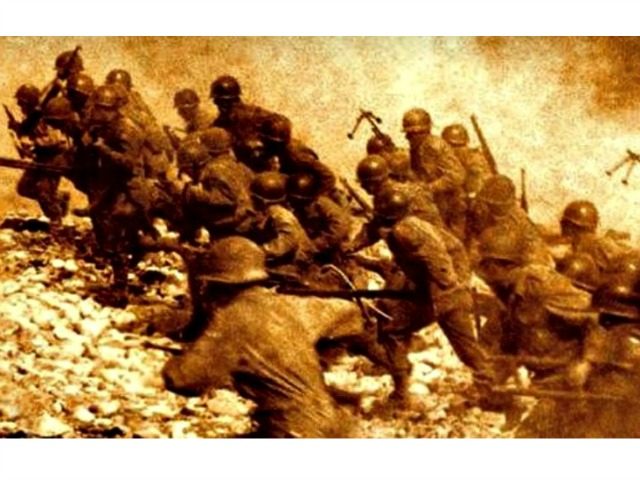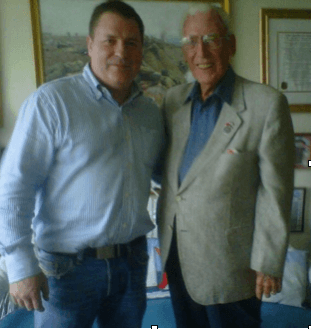A new television series, Hitler’s Last Stand, on the National Geographic Channel captures one of the great unknown battles of WWII, the epic stand of the 2nd Ranger Battalion at Hill 400.
“Fix bayonets!” barked a hulking Ranger officer.
In a scene reminiscent of a World War I battle, Germans and Americans stared at each other across a vast no man’s land. Lt. Leonard Lomell and his fellow Rangers gazed across the icy, flat expanse. They realized it made an ideal killing field and wondered if they would live long enough to cross the field and make it up the hill. The Rangers were huddled behind an embankment. In bunkers and foxholes on the other side of the field, Germans held their fingers poised on the triggers of their machine guns, which boasted a rate of fire of up to 1,500 rounds per minute. The gunners stood ready to tear the Rangers’ bodies to pieces.
At that moment, a newbie Ranger officer barked out a ridiculous order: “Send out a scout!”
“F*** you!” several veteran Rangers yelled back.
But the officer persisted until one of the privates obediently stood and started walking across the field. In stunned silence, the men watched the private collapse, taking a rifle shot to the belly after no more than four steps. “This was the fuse that ignited the explosion of the Ranger charge.”
The full story is captured in my best-selling book Dog Company: The Boys of Pointe du Hoc–the Rangers Who Accomplished D-Day’s Toughest Mission and Led the Way across Europe. It follows the Rangers of D Company from their training through D-Day and throughout the war.
Along the Ranger line, the men could hear the deafening sound of heavy artillery.
Boom! Boom! Boom! Boom!
Like a tightly wound coiled spring, tension within the Rangers’ ranks reached a breaking point. A creeping artillery barrage and mortars slowly closed in on the 2nd Ranger’s Dog Company.
Suddenly, a Ranger stood up, raised his tommy gun above his head, and screamed: “Let’s go get the bastards!”
The Rangers fired a tremendous volley into the German positions facing them. In unison, they stood and let loose a blood-curdling Rebel yell as they charged across the open field.
“Wa-woo-woohoo! Wa-woo-woohoo! Wa-woo-woohoo!”
“We stood up just like in a movie,” one Ranger later remembered. “It was like seeing a wave at the football field. … We went over the field as one. With bayonets shining, hip-firing, and yelling a battle cry that probably goes back into the eons of time, we charged into the jaws of death.”
The Rangers shot, blasted and bayoneted their way up the hill. Sustaining massive casualties, Dog (or D) Company of the 2nd Ranger Battalion, along with its sister unit, Fox Company, seized Hill 400.
But the Battle of Hill 400 was far from the first time Dog Company had an impact on war.
D-Day
Six months earlier, on June 6, 1944, the men of Dog Company and other elements of the Second Ranger Battalion took on what was arguably D-Day’s toughest mission. They scaled the 90-foot cliffs of Pointe du Hoc under direct machine-gun and artillery fire while German soldiers threw grenades down upon them. Using ropes and their bare hands, the men of Dog Company scaled the precipice.
One of those Rangers was Leonard Lomell, Dog Company’s inspiring first sergeant, who continued to climb, even after being wounded in the side by a bullet from a machine gun.
Once on top, Dog Company fought its way through a Guns of Navarone–like labyrinth of bunkers, tunnels, machine-gun nests, and tens of thousands of mines. Somehow, Lomell and his close friend Jack Kuhn found the guns that hundreds of Allied bombers and thousands of Naval shells failed to destroy. Because the big guns could reach Omaha Beach, Utah Beach, and the Allied armada in the English Channel, taking them out was a top priority. They had to be neutralized at all costs. Lomell disabled the guns with thermite grenades.
For two days, Lomell and the rest of Dog Company sustained tremendous casualties, endured relentless German counterattacks, and — somehow — held the line against overwhelming numbers.
The Rangers’ accomplishments at Pointe du Hoc were nothing short of awe-inspiring. Yet somewhat surprisingly, the soldiers involved didn’t consider it their most difficult battle. I interviewed all the survivors in the 1990s, and to a man, the Rangers of Dog Company all said one thing to me: “Patrick, our longest day was not D-day but Hill 400, in the Hürtgen Forest.”
The Ranger’s Longest Day
In the first week of December 1944, the Allies made one of their deepest penetrations into the Third Reich at Bergstein, Germany. Looming behind the town of Bergstein was one of the most important hills in the Hürtgen Forest, the scene of one of the U.S. Army’s longest and most costly battles in Europe. On a clear day, one could see from Hill 400, as the Allies called it, into one of Germany’s greatest secrets of the war — the preparations for the Battle of the Bulge.
The Germans wanted to retain control of Hill 400 at all costs.
The Americans sent nearly an entire tank regiment to seize Bergstein and Hill 400. The Germans viciously counterattacked, nearly destroying the unit.
Hand-to-hand fighting raged in Bergstein. The scene resembled a miniature Stalingrad: The fighting was house-to-house, and dozens of Sherman tanks were destroyed by German grenadiers and anti-tank guns.
After two days of intense fighting, the GIs in Bergstein barely hung on. One remembered: “Had daylight arrived 15 minutes later, we would never have been able to hold Bergstein.”
That’s when the men of the Second Ranger Battalion received orders to reinforce the town and seize Hill 400.
The Rangers’ arrival immediately changed the course of the operation. One GI recalled that several Ranger officers appeared near the German hamlet. “They asked for the enemy positions and the road to take. They said that they were ready to go.”
The officers then turned to the other Rangers in their group and said, “Let’s go, men.”
“We heard the tommy guns click,” the GI remembered. “Without saying a word, the Rangers moved out. Our morale went up in a hurry.”
The Rangers passed by dozens of burning or burned-out Sherman tanks. Gored in its attempt to take Bergstein and Hill 400, the doomed regiment had been reduced to the equivalent of a company. “It was a haunting feeling,” recalled one Ranger. “We saw hulks of destroyed American tanks … The sight of GIs whose bodies were charred and blackened in the tanks … the smell of blood.”
Armed only with their tommy guns and assorted small arms, the men of the Second Ranger Battalion embarked on a suicide mission, just as they had on Pointe du Hoc, and waged a frontal assault to clear the town of Bergstein and capture the hill.
After the daring bayonet charge across the ice-covered field, which took the lives of many Rangers, small groups of men from Dog and Fox Companies seized the hill, taking out scores of German positions along the way.
Within an hour, the Germans counterattacked with hundreds of troops, outnumbering the Rangers many times over.
The hill shook as 18 battalions of German artillery initially allocated for the Battle of the Bulge plastered 400. Len Lomell recalled the scene: “The artillery fell like rain. Have you ever been in a torrential rainstorm? Now picture yourself trying to hide from those raindrops. Instead of rain, it’s falling shrapnel, deadly shrapnel rain.”
The shells kept coming down as if they were “belt-fed” — like machine-gun fire. With only a couple dozen men, the Rangers held off hundreds of enemy troops. Moving their tiny forces from one position on the hill to another, they stopped each German counterattack.
Sergeant Edward Secor from D Company single-handedly halted one attack. As hundreds of elite German paratroopers rushed his foxhole, his Browning automatic rifle was hit by a bullet, rendering it useless. In a scene reminiscent of Where Eagles Dare, Secor picked up two MP-40 machine pistols from dead German soldiers whose bodies lay only feet in front of his foxhole, and madly charged into the oncoming counterattack. “With a captured machine pistol under each arm, he stood up to turn twin streams of demoralizing fire on the close-in enemy.”
The Rangers continually requested reinforcements to support their dwindling numbers. None were available. They were told flatly, “Hold the hill at all costs.” As the fighting continued, dead and wounded Rangers piled up inside the troop shelter atop 400.
By this time, the Rangers were down to fewer than 20 men, and many of the survivors were wounded — some several times over. But even the severely wounded manned fighting positions. One of Lomell’s fingers was dangling from a tendon, “half dropping off.” A fellow Ranger recalled Lomell’s presence on the hill: “I can still see Len walking on the top of that hill, his blood coming from his hand, and carrying his tommy gun. A leader like that we would do anything for.”
The Germans desperately wanted to retake Hill 400. They sent an elite parachute battalion against the Rangers and even offered German soldiers the Iron Cross and two weeks of furlough if they recaptured the hill. The Reich wanted the hill because it provided high ground for artillery. What is more important, they wanted it because it provided observation into the assembly areas in which they were assembling for the Battle of the Bulge, an operation cloaked in secrecy. The capture of the hill could have unraveled Hitler’s last great counteroffensive.
Miraculously, the men of Dog Company and Fox Company continued to fend off German attacks and held the hill until December 8, when an infantry unit finally arrived.
The GIs who relieved the Rangers later reported a “considerable moving of troops in the enemy’s rear.” But no one in the chain of command connected the dots. On December 16, the Battle of the Bulge began in a furious assault on Allied lines, with the sort of total surprise the Americans had not experienced since Pearl Harbor.
Patrick K. O’Donnell is the main expert participant in Episode 3 of “Hitler’s Last Stand: Forest of Death,” which tells the dramatic story of the Rangers on Hill 400 and is drawn from his book Dog Company. The program premiers Monday, June 25 at 10 p.m. ET on The National Geographic Channel.
O’Donnell is a bestselling, critically acclaimed military historian and an expert on elite units. He is the main expert participant in Episode 3 of “Hitler’s Last Stand: Forest of Death,” which is drawn from his book Dog Company and premiers Monday, June 25 at 10 p.m. ET on The National Geographic Channel. He is the author of eleven books. The Unknowns: The Untold Story of America’s Unknown Soldier and WWI’s Most Decorated Heroes Who Brought Him Home is his newest, and it is featured in Barnes & Noble stores. O’Donnell served as a combat historian in a Marine rifle platoon during the Battle of Fallujah and speaks often on espionage, special operations, and counterinsurgency. He has provided historical consulting for DreamWorks’ award-winning miniseries Band of Brothers and for documentaries produced by the BBC, the History Channel, and National Geographic. @combathistorian


COMMENTS
Please let us know if you're having issues with commenting.